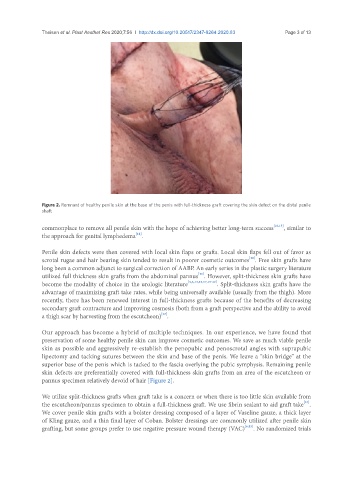Page 647 - Read Online
P. 647
Theisen et al. Plast Aesthet Res 2020;7:56 I http://dx.doi.org/10.20517/2347-9264.2020.83 Page 3 of 13
Figure 2. Remnant of healthy penile skin at the base of the penis with full-thickness graft covering the skin defect on the distal penile
shaft
commonplace to remove all penile skin with the hope of achieving better long-term success [16,17] , similar to
[12]
the approach for genital lymphedema .
Penile skin defects were then covered with local skin flaps or grafts. Local skin flaps fell out of favor as
[18]
scrotal rugae and hair bearing skin tended to result in poorer cosmetic outcomes . Free skin grafts have
long been a common adjunct to surgical correction of AABP. An early series in the plastic surgery literature
[10]
utilized full thickness skin grafts from the abdominal pannus . However, split-thickness skin grafts have
become the modality of choice in the urologic literature [5,6,13,16,17,19-22] . Split-thickness skin grafts have the
advantage of maximizing graft take rates, while being universally available (usually from the thigh). More
recently, there has been renewed interest in full-thickness grafts because of the benefits of decreasing
secondary graft contracture and improving cosmesis (both from a graft perspective and the ability to avoid
[23]
a thigh scar by harvesting from the escutcheon) .
Our approach has become a hybrid of multiple techniques. In our experience, we have found that
preservation of some healthy penile skin can improve cosmetic outcomes. We save as much viable penile
skin as possible and aggressively re-establish the penopubic and penoscrotal angles with suprapubic
lipectomy and tacking sutures between the skin and base of the penis. We leave a “skin bridge” at the
superior base of the penis which is tacked to the fascia overlying the pubic symphysis. Remaining penile
skin defects are preferentially covered with full-thickness skin grafts from an area of the escutcheon or
pannus specimen relatively devoid of hair [Figure 2].
We utilize split-thickness grafts when graft take is a concern or when there is too little skin available from
the escutcheon/pannus specimen to obtain a full-thickness graft. We use fibrin sealant to aid graft take .
[24]
We cover penile skin grafts with a bolster dressing composed of a layer of Vaseline gauze, a thick layer
of Kling gauze, and a thin final layer of Coban. Bolster dressings are commonly utilized after penile skin
grafting, but some groups prefer to use negative pressure wound therapy (VAC) [6,25] . No randomized trials

